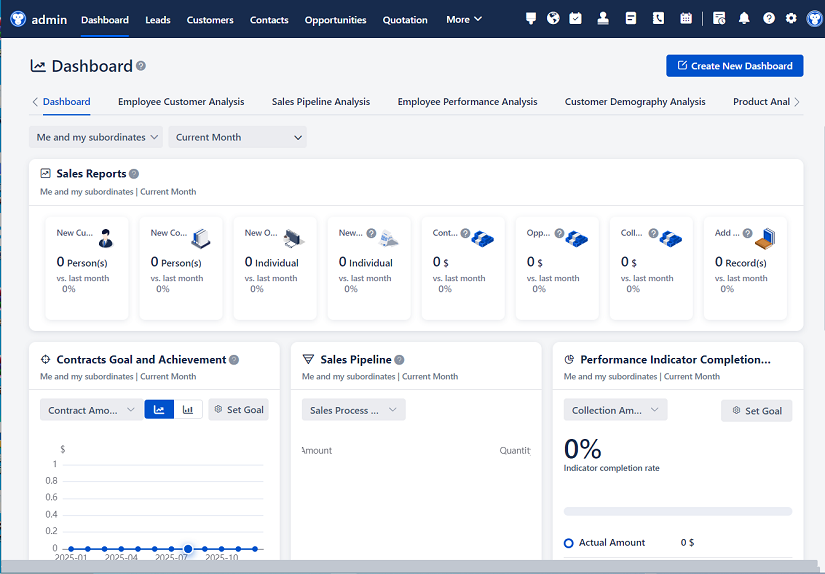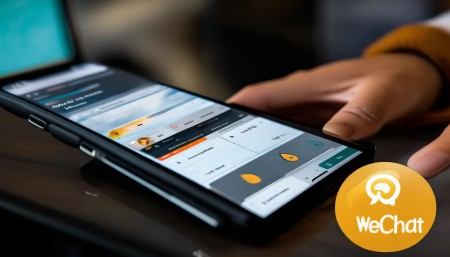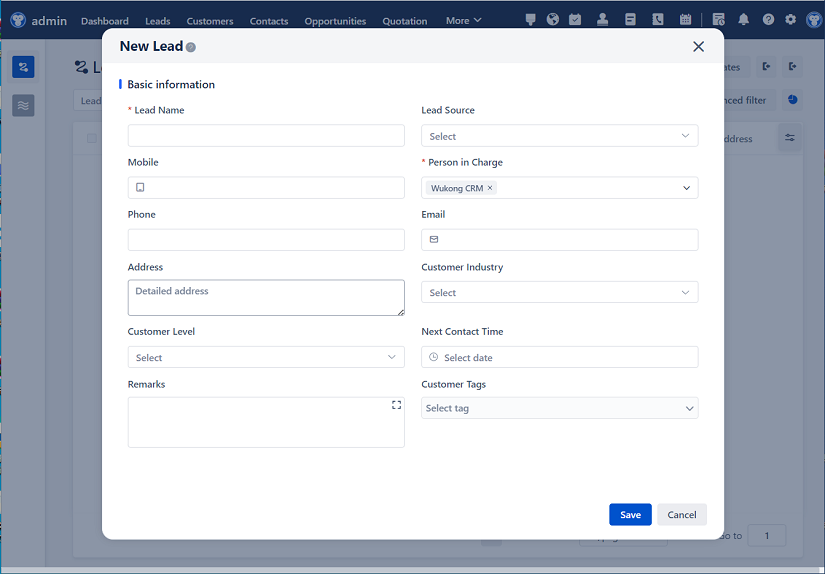
△Click on the top right corner to try Wukong CRM for free
So, you know how running a small business can be kind of overwhelming sometimes? I mean, you’ve got customers coming in from all directions—some through email, some calling, some showing up in person, and now, more than ever, a ton of them are reaching out through messaging apps. And honestly, keeping track of all that? It’s a mess. I’ve been there. You end up with sticky notes everywhere, half-filled spreadsheets, and that one notebook you swear you’ll organize “later.” But then “later” never comes.

Well, here’s something I recently came across that actually made me go, “Wait, why didn’t I think of this?” It’s this lightweight CRM system built right into WeChat Official Accounts. Yeah, WeChat—the app everyone in China uses for, like, everything. And honestly, if you’re running a small business or even a mid-sized one targeting Chinese customers, this could be a total game-changer.

Let me break it down. So, a CRM—Customer Relationship Management system—is basically a tool that helps you manage your interactions with current and potential customers. Big companies use these fancy, expensive platforms like Salesforce or HubSpot. But for smaller teams? Those are overkill. They’re complicated, they cost a fortune, and honestly, most of the features just sit there unused. What you really need is something simple, something that fits into the tools your customers are already using.
And that’s where WeChat comes in. Think about it—people are already on WeChat all the time. They use it to chat, pay bills, order food, book appointments, you name it. So instead of asking them to switch to email or call a hotline, why not meet them where they already are? That’s the whole idea behind this lightweight CRM built on WeChat Official Accounts.

Here’s how it works. First, you set up a WeChat Official Account. That’s like your business’s public profile on the platform. Once that’s done, you can start building automated interactions. For example, when someone follows your account, they get a welcome message—maybe a quick intro to your services or a special discount for new followers. Pretty standard, right? But here’s where it gets smart.
You can set up keyword-based responses. So if someone types “pricing,” they instantly get a message with your service packages. Type “support,” and they’re guided to the right contact or even a chatbot that can answer common questions. It’s like having a 24/7 assistant who never gets tired.
But it’s not just about automation. The real power comes from how it helps you track customer interactions. Every time someone messages your Official Account, that conversation gets logged. You can see who reached out, when, and what they asked. And because WeChat ties each user to a unique ID, you can start building a profile over time. No more guessing who’s who.
I remember one time, a customer messaged us asking about a product they’d seen three months ago. Without this system, we’d have had no idea who they were or what they wanted. But thanks to the CRM, we pulled up their history, saw they’d asked about delivery options before, and were able to give them a personalized update. They ended up making a purchase that same day. Small thing? Maybe. But it showed how powerful even basic tracking can be.
And the best part? It doesn’t require a huge tech team to set up. Most of the tools are built into WeChat’s platform. You don’t need to code from scratch. There are third-party plugins and mini-programs you can integrate—things like appointment booking, order tracking, feedback forms. All of it runs inside WeChat, so the user never has to leave the app.
Now, I know what you’re thinking: “But isn’t WeChat kind of closed off? Can you really build a full CRM inside it?” Fair question. And yeah, WeChat does have some limitations. You can’t export data as freely as you might want, and some advanced analytics aren’t built in. But here’s the thing—this isn’t meant to replace enterprise CRMs. It’s designed for simplicity. It’s for businesses that want to do more with less.
Let me give you a real example. A friend of mine runs a small fitness studio in Shanghai. Before, she was using a mix of WeChat chats, paper sign-ups, and Google Sheets to manage clients. It was chaotic. People would book classes via message, but sometimes she’d miss it, or double-book someone. Attendance tracking was a nightmare.
Then she set up a WeChat Official Account with a simple CRM system. Now, when someone follows her account, they get a menu: “Book a Class,” “View Schedule,” “Contact Us.” Click “Book a Class,” and it pulls up the next available sessions. They pick one, confirm, and boom—it’s in the system. She gets a notification, the class list updates automatically, and the client gets a reminder the day before.

She told me it cut her admin time by at least 60%. And because everything’s tracked, she can see who’s attending regularly, who’s dropped off, and send targeted messages—like, “Hey, we miss you! Here’s 10% off your next session.” Personal, timely, and effective.
Another cool thing? Integration with payment. WeChat Pay is built right in. So if someone books a class or buys a package, they can pay instantly without leaving the chat. No redirecting to a website, no filling out forms. Just tap, confirm, done. That kind of frictionless experience? Huge for conversion.
And let’s talk about scalability. You might think this only works for tiny businesses. But actually, even larger companies are using this approach for specific departments or customer segments. Like a university in Guangzhou uses it for student inquiries. Prospective students follow the account, get automated answers to FAQs, and can schedule campus tours—all without a single staff member getting involved until necessary.
It’s not perfect, though. One challenge is data ownership. Since everything runs on WeChat’s platform, you’re kind of at the mercy of their rules. If they change their API or restrict certain features, you have to adapt. And while you can export some data, it’s not always in the cleanest format. So if you need deep analytics or want to feed this into other systems, it takes extra work.
Also, language can be a barrier. Most of the documentation and support are in Chinese. If you’re not fluent, setting it up might require hiring a local developer or consultant. But honestly, once it’s running, day-to-day management is pretty intuitive—even for non-tech folks.
Another thing people worry about is privacy. I get it. You’re collecting customer data inside a third-party app. But WeChat does have data protection policies, and as a business, you can control what info you collect and how you use it. Just make sure you’re transparent with users and follow local regulations.
What I love most about this approach is how it flips the script on traditional CRM. Instead of forcing customers into your system, you’re joining theirs. You’re not asking them to download an app or create an account. You’re meeting them in a space they already trust and use every day.
And let’s be real—customer attention is scarce. If you make it even slightly inconvenient to reach you, people will just give up. But if you’re right there in their chat list, one tap away? That’s convenience. That’s service.
I’ve seen businesses go from being reactive to proactive with this setup. Instead of waiting for customers to message first, they send helpful updates—like “Your favorite product is back in stock” or “We noticed you haven’t booked in a while—here’s a little gift.” It feels personal, not spammy, because it’s based on real interactions.
And because WeChat supports rich media, you can send images, videos, even mini-games or surveys. One beauty brand I know uses it to send skincare tips based on the products a customer bought. Another uses it for post-purchase check-ins: “How’s your new blender working out?” That kind of follow-up builds loyalty in a way cold emails never could.
Now, is this the right solution for everyone? Probably not. If you’re managing thousands of complex B2B deals with long sales cycles, you’ll still need a full-featured CRM. But for service-based businesses, retail, education, healthcare clinics—anywhere the customer journey is relatively short and communication is frequent—this lightweight model makes a ton of sense.
Plus, it’s cost-effective. Setting up a WeChat Official Account is free. The tools and plugins? Most are low-cost or even free for basic use. Compare that to paying hundreds or thousands per month for cloud CRM subscriptions. For startups and small teams, that’s a huge difference.
And let’s not forget mobile-first design. WeChat is inherently mobile. So your CRM works seamlessly on phones—where most people are. No clunky desktop interfaces or apps that crash. It’s just smooth, fast, and familiar.
I’ll admit, when I first heard about this, I was skeptical. “How can a messaging app handle CRM tasks?” But after seeing it in action—both in my own work and in others’—I’m convinced. It’s not about replacing traditional systems. It’s about rethinking how we connect with customers in a mobile, messaging-driven world.
So if you’re struggling with customer follow-ups, losing leads in the chaos, or just want a simpler way to stay organized, maybe it’s time to look at what WeChat Official Accounts can do. You don’t need a big budget or a tech team. Just a clear idea of what your customers need and how you can serve them—right where they already are.
It’s not flashy. It’s not trying to be the next big AI-powered platform. But sometimes, the best solutions are the quiet ones that just… work.
FAQs (Frequently Asked Questions)
Q: Can I use this CRM system if my business isn’t in China?
A: Absolutely. As long as your target customers use WeChat—like Chinese tourists, expats, or international students—this can work. Many overseas businesses serving Chinese clients use WeChat Official Accounts successfully.
Q: Do I need to know how to code to set this up?
A: Not really. Most features can be configured using WeChat’s built-in tools or third-party platforms that offer drag-and-drop interfaces. For advanced features, you might need a developer, but basic CRM functions are user-friendly.
Q: How do I keep customer data secure?
A: WeChat has enterprise-level security, but you should still follow best practices—like not storing sensitive info in plain text and limiting access to your admin account. Also, comply with data protection laws like GDPR or China’s PIPL.
Q: Can I integrate this with other tools like Excel or Google Sheets?
A: Yes, through APIs or third-party automation tools like Zapier (with some limitations). You can export chat logs and user data, then sync them to external systems for reporting or analysis.
Q: What if WeChat changes its policies or shuts down my account?
A: It’s rare, but possible. Always keep backups of your customer data and have a communication plan—like collecting emails as a secondary contact method—just in case.
Q: Is this suitable for B2B companies?
A: It depends. If your B2B interactions are frequent and relationship-driven—like consulting or training—it can work well. For complex sales cycles with multiple stakeholders, a traditional CRM might still be better.
Q: How do I get started?
A: First, apply for a WeChat Official Account (choose “Service Account” for CRM use). Then explore built-in features like auto-replies and menus. Add mini-programs for booking or payments. Test with a small group, then scale up.
Related links:
Free trial of CRM
Understand CRM software
AI CRM Systems

△Click on the top right corner to try Wukong CRM for free